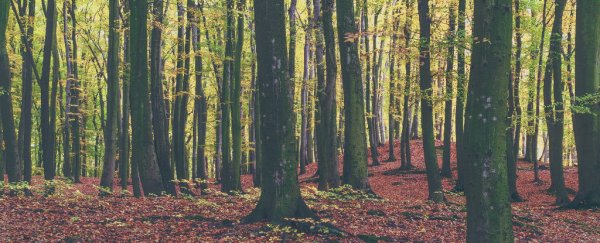Over the past 30 years, three-quarters of eastern US tree species have been shifting to the west, and at an astonishing rate of around 15.4 kilometres per decade (9.5 miles).
That's weird, because scientists have long predicted that the effects of climate change would send species towards the poles in search of familiar climates, but since 1980, more eastern trees have been moving west instead of north. And at this stage, it's not entirely clear why.
And the fact that more eastern trees are moving westward than northward isn't even the strangest part. Researchers estimate that even if we took certain knock-on effects of climate change into consideration, such as changes in rainfall and precipitation, it can only explain a fraction of the movement.
Something else is going on here - or many somethings in accumulation - and scientists are still trying to make sense of it.
"[It] was a huge surprise for us," lead researcher Songlin Fei, a forest ecologist from Purdue University, told Emma Marris at Nature.
Fei and his team analysed 30 years' worth of data from the US Forest Service, which covered the movements of 86 tree species between 1980 and 2015. These trees were located between Maine and Minnesota, and as far south as Florida.
They found that more species had made shifts towards the west than to the north during this period, and the young trees were more likely to have made this westward migration than the older ones.
Some trees made their way in both directions, towards the northwest.
"We show that more tree species have experienced a westward shift (73 percent) than a poleward shift (62 percent) in their abundance, a trend that is stronger for saplings than adult trees," the researchers report in their paper.
Now, to be clear, trees don't migrate by hitching up their roots and trudging through the forest like IRL Ents - but they are known for gradually shifting their population centres over many years to places that offer better conditions.
When times get tough in one area, saplings will start cropping up in another, more suitable habitat, and once the older population dies out, the species will have established a new home.
The process, while gradual, is happening faster than you might think in the eastern US, with Fei and his team finding that westward-moving trees have been shifting at a rate of 15.4 km per decade, while northward-moving trees have been clearing about 11 km per decade (6.8 miles).
Hardly any of the species made a break for the south or east during this time period.
The researchers also found that between 1980 and 2015, the mean annual temperature in the eastern US increased by about 0.16 degrees Celsius on average (0.29 degrees Fahrenheit).
Conventional wisdom states that as the temperature rises, species that are used to the cold will move further north, away from the tropics, but that's not what happened here.
In an effort to explain the westward charge, the Purdue researchers hypothesise that precipitation changes brought on by global warming could be at play.
"While climate change has elevated temperatures across the eastern US, it has significantly altered rainfall totals," Robinson Meyer reports for The Atlantic.
"The northeast has gotten a little more rain since 1980 than it did during the proceeding century, while the southeast has gotten much less rain. The Great Plains, especially in Oklahoma and Kansas, get much more than historically normal."
"Different species are responding to climate change differently. Most of the broad-leaf species - deciduous trees - are following moisture moving westward," Fei told him.
"The evergreen trees - the needle species - are primarily moving northward."
That makes sense, but there's one catch.
Fei says his team could only argue that "at least 20 percent" of the shift in population could be explained by human-caused precipitation changes, because one fact remains - while the west is now wetter than it used to be it's still not wetter than where the trees were originally in the east.
Fei says each species responds to the pressures of climate change and other aspects of human activity differently, meaning the causes behind this phenomenon are far more nuanced than rising temperatures moving things one way or another.
"Trees are shifting partially because of climate change, but their responses are species specific," he explains in a press release.
It's likely that the migration is down to a number of factors, such as changes in how we're using the land, new pest infestations, and conservation and planting projects - something that future research will need to model extensively before we can know for sure why trees are moving the way they are.
But the team is careful to point out that just because we can't slap a "100 percent climate change is to blame" stamp on this one doesn't mean that we can get complacent.
"There is still some skepticism out there about climate change," Fei told Kate Lunau at Motherboard. "[W]e're saying, let's look at what's actually happened. We wanted to show the reality, not speculations."
And when you see the rapid changes in the environment in response to climate change, she adds, "Is our society ready to adapt?"
The research has been published in Science Advances.
